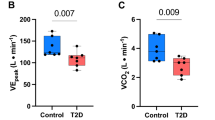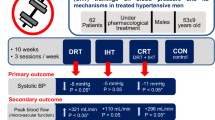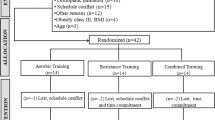Abstract
As the leading cause of cardiovascular disease and mortality, hypertension remains a global health problem. Isometric exercise training (IET) has been established as efficacious in reducing resting blood pressure (BP); however, no research to date has investigated its effects on the myocardial performance index (MPI). Twenty-four unmedicated hypertensive patients were randomized to 4 weeks of IET and a control period in a crossover design. Tissue Doppler imaging was used to acquire cardiac time intervals pre- and post-IET and during the control periods. IET significantly improved all measures of cardiac time intervals, including isovolumic relaxation time (83.1 ± 10.3 vs. 76.1 ± 11.2 ms, p = 0.006), isovolumic contraction time (84.8 ± 10.3 vs. 72.8 ± 6.4 ms, p < 0.001), ejection time (304.6 ± 30.2 vs. 321.4 ± 20.8 ms, p = 0.015) and the MPI (0.56 ± 0.09 vs. 0.47 ± 0.05, p < 0.001). This is the first study to demonstrate that IET significantly improves cardiac time intervals. These findings may have important clinical implications, highlighting the potential utility of IET in the management of cardiac health in hypertensive patients.
This is a preview of subscription content, access via your institution
Access options
Subscribe to this journal
Receive 12 print issues and online access
$259.00 per year
only $21.58 per issue
Buy this article
- Purchase on Springer Link
- Instant access to full article PDF
Prices may be subject to local taxes which are calculated during checkout


Similar content being viewed by others
References
Lim SS, Vos T, Flaxman AD, Danaei G, Shibuya K, Adair-Rohani H, et al. A comparative risk assessment of burden of disease and injury attributable to 67 risk factors and risk factor clusters in 21 regions, 1990-2010: A systematic analysis for the Global Burden of Disease Study 2010. Lancet. 2012;380:2224–60. https://doi.org/10.1016/S0140-6736(12)61766-8
Ettehad D, Emdin CA, Kiran A, Anderson SG, Callender T, Emberson J, et al. Blood pressure lowering for prevention of cardiovascular disease and death: A systematic review and meta-analysis. Lancet. 2016;387:957–67. https://doi.org/10.1016/S0140-6736(15)01225-8
Lewington S, Clarke R, Qizilbash N, Peto R, Collins R. Age-specific relevance of usual blood pressure to vascular mortality: A meta-analysis of individual data for one million adults in 61 prospective studies. Lancet. 2002;360:1903–13. https://doi.org/10.1016/S0140-6736(02)11911-8
Drazner MH. The progression of hypertensive heart disease. Circulation. 2011;123:327–34. https://doi.org/10.1161/CIRCULATIONAHA.108.845792
Taylor KA, Wiles JD, Coleman DA, Leeson P, Sharma R, O’Driscoll JM. Neurohumoral and ambulatory haemodynamic adaptations following isometric exercise training in unmedicated hypertensive patients. J Hypertens. 2019;37:827–36. https://doi.org/10.1097/HJH.0000000000001922
O’Driscoll JM, Edwards JJ, Wiles JD, Taylor KA, Leeson P, Sharma R. Myocardial work and left ventricular mechanical adaptations following isometric exercise training in hypertensive patients. Eur J Appl Physiol. 2022;122:727–34.
Reant P, Dijos M, Donal E, Mignot A, Ritter P, Bordachar P, et al. Systolic time intervals as simple echocardiographic parameters of left ventricular systolic performance: Correlation with ejection fraction and longitudinal two-dimensional strain. Eur J Echocardiogr. 2010;11:834–44. https://doi.org/10.1093/ejechocard/jeq084
Ärnlöv J, Ingelsson E, Risérus U, Andrén B, Lind L. Myocardial performance index, a Doppler-derived index of global left ventricular function, predicts congestive heart failure in elderly men. Eur Heart J. 2004;25:2220–5. https://doi.org/10.1016/j.ehj.2004.10.021
Biering-Sørensen T, Mogelvang R, Schnohr P, Jensen JS. Cardiac time intervals measured by tissue Doppler imaging M-mode: Association with hypertension, left ventricular geometry, and future ischemic cardiovascular diseases. J Am Heart Assoc. 2016; 5. https://doi.org/10.1161/JAHA.115.002687
Masugata H, Senda S, Goda F, Yamagami A, Okuyama H, Kohno T, et al. Independent determinants of the Tei index in hypertensive patients with preserved left ventricular systolic function. Int Heart J. 2009;50:331–40. https://doi.org/10.1536/ihj.50.331
Whelton PK, Carey RM, Aronow WS, Casey DE, Collins KJ, Dennison Himmelfarb C, et al. 2017 ACC/AHA/AAPA/ABC/ACPM/AGS/APhA/ASH/ASPC/NMA/PCNA Guideline for the Prevention, Detection, Evaluation, and Management of High Blood Pressure in Adults: Executive Summary: A Report of the American College of Cardiology/American Heart Association Task F. In Journal of the American Society of Hypertension. Elsevier, 2018, 579.e1-579.e73.
Wiles JD, Coleman DA, Swaine IL. The effects of performing isometric training at two exercise intensities in healthy young males. Eur J Appl Physiol. 2010;108:419–28. https://doi.org/10.1007/s00421-009-1025-6
Beevers DG (DG, Lip GYH, O’Brien E ABC of hypertension. BMJ Books/Blackwell
Lo Q, Thomas L. Echocardiographic evaluation of diastolic heart failure. Australas J Ultrasound Med. 2010;13:14–26. https://doi.org/10.1002/j.2205-0140.2010.tb00214.x
Grant ADM, Negishi K, Negishi T, Collier P, Kapadia SR, Thomas JD, et al. Grading diastolic function by echocardiography: Hemodynamic validation of existing guidelines. Cardiovasc Ultrasound. 2015; 13. https://doi.org/10.1186/s12947-015-0023-6
Zheng H, Luo M, Shen Y, Fang H. Improved left ventricular diastolic function with exercise training in hypertension: a doppler imaging study. Rehabil Res Pr. 2011;2011:1–6. https://doi.org/10.1155/2011/497690
Molmen-Hansen HE, Stolen T, Tjonna AE, Aamot IL, Ekeberg IS, Tyldum GA, et al. Aerobic interval training reduces blood pressure and improves myocardial function in hypertensive patients. Eur J Prev Cardiol. 2012;19:151–60. https://doi.org/10.1177/1741826711400512
Biering-Sørensen T, Mogelvang R, Jensen JS. Prognostic value of cardiac time intervals measured by tissue Doppler imaging M-mode in the general population. Heart. 2015;101:954–60. https://doi.org/10.1136/heartjnl-2014-307137
Asami M, Pilgrim T, Lanz J, Heg D, Franzone A, Piccolo R, et al. Prognostic relevance of left ventricular myocardial performance after transcatheter aortic valve replacement. Circ Cardiovasc Interv. 2019; 12. https://doi.org/10.1161/CIRCINTERVENTIONS.118.006612
Goroshi M, Chand D. Myocardial Performance Index (Tei Index): A simple tool to identify cardiac dysfunction in patients with diabetes mellitus. Indian Heart J. 2016;68:83 https://doi.org/10.1016/J.IHJ.2015.06.022
Biering-Sørensen T, Mogelvang R, Pedersen S, Schnohr P, Sogaard P, Jensen JS. Usefulness of the myocardial performance index determined by tissue doppler imaging m-mode for predicting mortality in the general population. Am J Cardiol. 2011;107:478–83. https://doi.org/10.1016/j.amjcard.2010.09.044
Oh GC, Cho H-J. Blood pressure and heart failure. Clin Hypertens. 2020;26:1 https://doi.org/10.1186/s40885-019-0132-x
Millar PJ, McGowan CL, Cornelissen VA, Araujo CG, Swaine IL. Evidence for the role of isometric exercise training in reducing blood pressure: Potential mechanisms and future directions. Sport Med. 2014;44:345–56.
Author information
Authors and Affiliations
Corresponding author
Ethics declarations
Conflict of interest
The authors declare no competing interests.
Additional information
Publisher’s note Springer Nature remains neutral with regard to jurisdictional claims in published maps and institutional affiliations.
Rights and permissions
Springer Nature or its licensor holds exclusive rights to this article under a publishing agreement with the author(s) or other rightsholder(s); author self-archiving of the accepted manuscript version of this article is solely governed by the terms of such publishing agreement and applicable law.
About this article
Cite this article
Edwards, J.J., Jalaludeen, N., Taylor, K.A. et al. Myocardial performance index as a measure of global left ventricular function improves following isometric exercise training in hypertensive patients. Hypertens Res 46, 468–474 (2023). https://doi.org/10.1038/s41440-022-01019-7
Received:
Revised:
Accepted:
Published:
Issue Date:
DOI: https://doi.org/10.1038/s41440-022-01019-7
Keywords
This article is cited by
-
Exercise prescription in the treatment of hypertension
Hypertension Research (2023)



